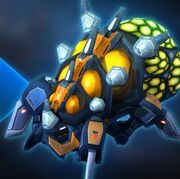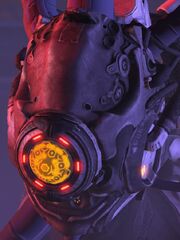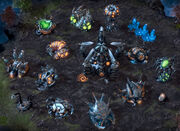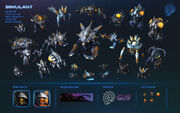
|
You may be looking for:
|
|

A simulant baneling
Simulants are a form of robotic zerg created by Project Simulant.
Overview

A simulant construct, apparently utilized in directing other simulants
A white, blood-like substance is located inside all simulants.[1] All of their structures are constructed from a polymeric alloy that mimics organic zerg structures.[2]
The simulants were created using entirely terran technology (supposedly) as part of Project Simulant.[3] They are mechanical reconstructions of various zerg breeds.[2]
Known Simulants
Units
- Baneling: A recreation of the baneling posed a unique problem for engineers, as their carefully harvested acid sacs kept melting through the surrounding plate infrastructure. Eventually they made it work.
- Brood lord: A brood lord prototype was created that exceeded all standards.
- Corruptor: Rather than spores, simulant corruptors posses self-replicating nanites that have been programmed to perform the same function. They are propelled using gas stored at simulant spires.
- Drone: The Simulant Project began with the construction of a mechanical drone that could be used during target practice to test alternate combat techniques and weapons, but it soon grew much larger.

A simulant hydralisk
- Hydralisk: Simulant hydralisks posed a significant risk to their creators, who chose to replace their claws with blades that could be easily dulled during the assembly process.
- Infestor: Researchers failed to create an AI that replicated the infestors' neural parasites. They were removing the infestors from production when, unexpectedly, the AI began functioning perfectly...
- Larva: Larva were designed to have the silhouette and gait of their organic counterparts, yet mysteriously engineers also added in the larva's signature squelching noises.
- Lurker: Extensive subterranean tests yielded a capable mechanized lurker, aside from its spikes, which were reshaped to better perform under blunt force impact.
- Mutalisk: Though the mutalisk struggled with initial weight tests, its eventual success lead to many new investors for the Simulant Project—some with ulterior motives. Similar to corruptors, it is propelled using gas stored at simulant spires.
- Overlord: An early creation during the course of the Simulant Project, the overlord was carefully controlled by a lab scientist, making it a critical safety point in the entire operation.

A simulant overseer
- Overseer: Unable to fully replicate the organic structure behind the overseer's eyes, the head engineer replaced them with detection sensors that fulfill largely the same purpose—aside from the aesthetics.
- Queen: The magnificent queen was the first completed production model to go missing. Loath to publicly reveal their activities, the Simulant Project investigated the matter as quietly as possible.
- Ravager: Simulant ravagers are fitted with heat-absorbent panels instead of spikes around their plasma fire receptacles to prevent damage to the rest of the model.
- Roach: These machines have been outfitted with a sophisticated self-repair system to replicate the roach's incredible healing ability, while also combating structural damage from its acid reserves.
- Swarm host: Engineers began to fall ill while working on the swarm host mechanics. However, its safety systems did not report a problem, and production continued undisturbed—fatalities aside.
- Ultralisk: Early on the project, it was agreed that the team would never construct a replica of the ultralisk. When chaos overtook the lab, it became clear that the agreement had been broken...
- Viper: A simulant viper was created, apparently near the end of the project's completion.
- Zergling: Though they look and act just like zerglings, the simulants are purely mechanical reproductions that run wholly on electrical power sources, rather than absorbing the DNA of their enemies.[2]
Structures

Simulant structures
- Baneling nest: The upper half of the baneling nest is held aloft by the same antigravity technology deployed in battlecruisers.
- Evolution chamber: The evolution chamber is constructed from a polymeric alloy capable of flexing to accommodate the rolling biomechanical processes within.
- Extractor: In the planning stages of Project Simulant, extractors were intended to be purely decorative. However, by the end of the project these extractors shifted to full vespene production.
- Hatchery/Lair/Hive: Near the end of Project Simulant, the replica hatcheries began producing a substance indistinguishable from creep.
- Hydralisk den: The spines on the Simulant hydralisk den were deadly vanadium blades, though investigators were never able to ascertain who added them.
- Infestation pit: The first suggestion of the Simulant Project AI malfunction came when the infestor den stopped responding to its maintenance technicians.
- Lurker den: The Simulant Lurker den generates nano-tipped lurker spines using extreme heat, and is cool through a series of vents and cooling fins.
- Nydus network: After the end of Project Simulant, a convoluted network of nydus tunnels honeycombed the project's facility.
- Roach warren: Significant polymer-alloy innovations were necessary to develop innovations for the Simulant roach warren that would withstand the turmoil of its internal acid generation.
- Spawning pool: Polymer-titanium composites allow the simulant spawning pool to flex and conform to the volatile ooze it contains.
- Spine crawler: The spine crawler's spearpoint terminating in a monomolecular tip allows the Simulant spine crawler to penetrate even the thickest terran armor.
- Spire/Greater spire: The Simulant spire contains a reservoir of gas that keeps the top half afloat, and restraint cables hold it in place.
- Spore crawler: In the early stages of the project, Simulant spore crawlers were given fake ammunition. However, later, these were replaced with a nano-facsimile of real ammunition, which injured a terran pilot.
- Ultralisk cavern: The Simulant Project ultralisk cavern houses its radioactive innards within a converted battlecruiser engine heatshield.[2]
Notes

Simulant skinset
- A simulant skinset became available in the BlizzCon 2018 War Chest.[4] Simulant building skins were introduced in the Katowice 2019 War Chest.[5]
- It is unspecified whether simulants are identical to zerg-bots or a separate form of technology.
- A robotic zerg similar to a simulant appeared in Heroes of the Storm before the simulant skinset, as Kerrigan's "Queen of Ghosts" skin has a robotic duplicate of the ultralisk. The skin's description implies that the technology is of Umojan origin, and refers to it as a "robolisk."
- In Co-op Missions, Egon Stetmann fields an army of mechanical zerg named the Mecha Swarm that uses the Simulant skinset. However, Stetmann's Mecha Swarm is stated to have been built by him, while the Simulants were a result of Project Simulant, making them two separate groups of mechanical zerg.
References
- ↑ Blizzard Entertainment. StarCraft II: Legacy of the Void. (Activision Blizzard) (in English). November 10, 2015
- ↑ 2.0 2.1 2.2 2.3 Blizzard Entertainment. StarCraft II: Legacy of the Void. Collections Tab: Skins. July 19, 2017
- ↑ War Chest: BlizzCon® 2018, Blizzard Entertainment. Accessed on 2018-08-13
- ↑ 2018-08-02, StarCraft II - War Chest Season 3 Preview. YouTube, accessed on 2018-02-08
- ↑ 2018-11-06, NEW STARCRAFT 2 CO-OP COMMANDER ZERATUL, WAR CHEST 4 ANNOUNCED, BLIZZCON 2018. Blizzpro, accessed on 2018-11-13
